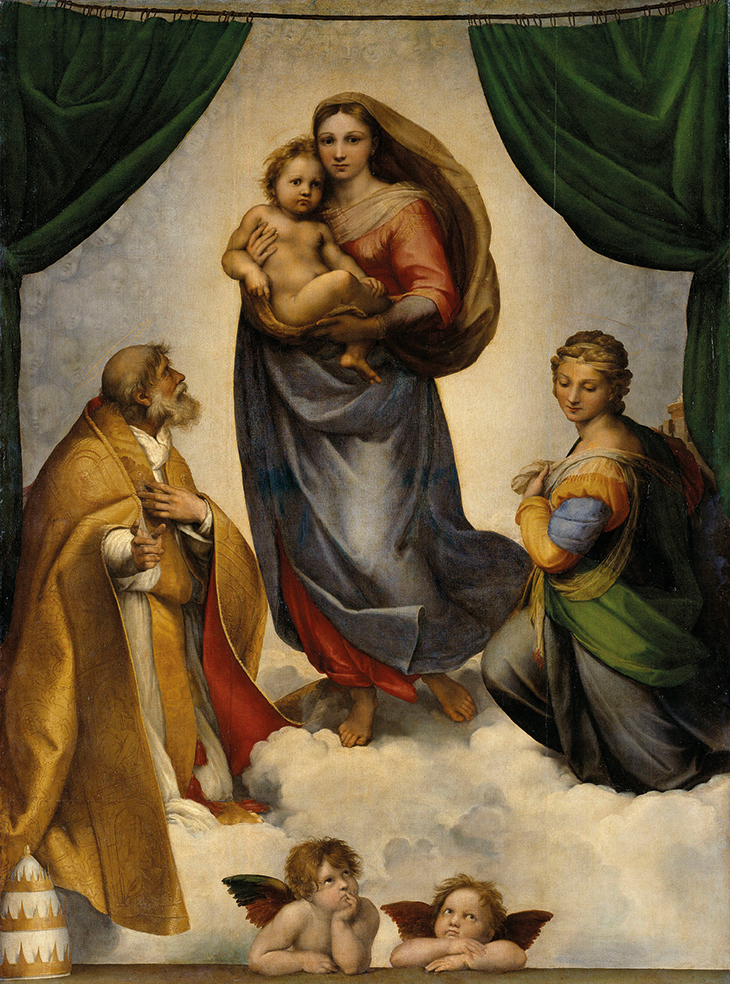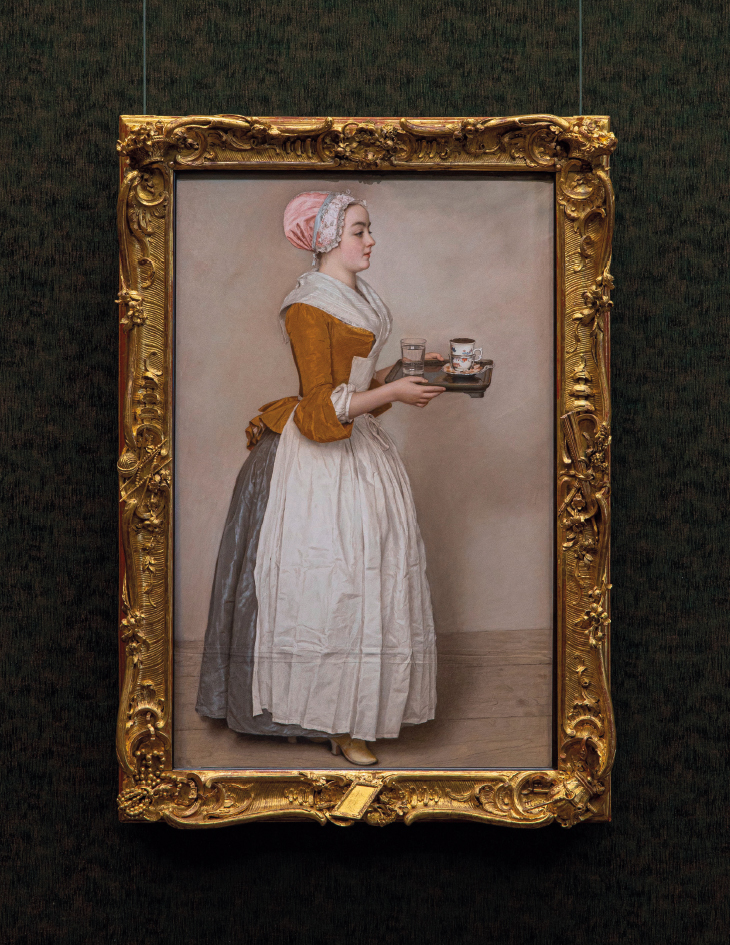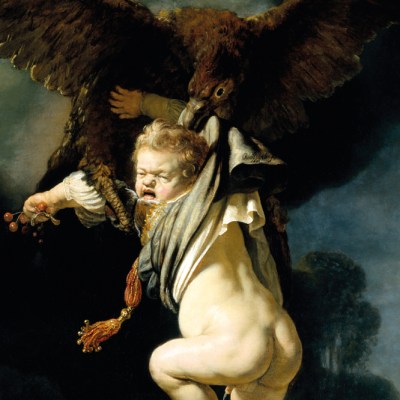Should a visitor to the Gemäldegalerie in Dresden be in any doubt as to the museum’s star attraction, they need only look up. Sitting atop Gottfried Semper’s neo-Renaissance facade, and outlined in lilac neon light tubes, are the two insouciant cherubs from Raphael’s Sistine Madonna. These glowing hieroglyphs are the work of Austrian artist Peter Baldinger, and not only proclaim what lies within but also that the Gemäldegalerie Alte Meister und Skulpturensammlung bis 1800 – to give the gallery its full title – has completed its renovations.
The gallery is one of 15 museums spread across eight buildings that fall under the city’s Staatliche Kunstsammlungen Dresden umbrella. It is by some distance, however, the most important. Its Old Master collection has been famous for its quality since the mid 18th century. As well as the Raphael, the gallery contains, among other things, Giorgione and Titian’s Sleeping Venus (c. 1508–10); Rembrandt’s startling and tragicomic The Abduction of Ganymede (1635); Vermeer’s slyly humorous The Procuress (c. 1656); and Jean-Étienne Liotard’s charming pastel of The Chocolate Girl (c. 1744). For the past seven years, however, the gallery has been largely closed for a thoroughgoing restoration with only a prized handful of its near 2,000-work picture collection and huge holdings of sculpture and antiquities on display.
Sleeping Venus (c. 1508–10), Giorgione and Titian. Gemäldegalerie Alte Meister, Dresden. Photo: Elke Estel/Hans-Peter Klut; © SKD

When Goethe saw the collection in the late 18th century, he wrote of his astonishment: ‘I entered this shrine, and my amazement exceeded any preconceived idea!’ It is a reaction the restored gallery will elicit from many first-time viewers. The quality and range of its holdings, sumptuously displayed, offer a history lesson in European art.
The origins of the collection lie with the Kunstkammer of Augustus, Elector of Saxony, founded in 1560. Here paintings were just one part of a mixed hoard: as Gabriel Kaltemarckt advised Augustus’s successor Christian I in 1587, a princely collection should have not just sculptures and paintings but also ‘curious items from home or abroad’ (corals, minerals, medals and the like) and ‘antlers, horns, claws, feathers and other things belonging to strange and curious animals’.
It was the accession in 1697 of Augustus the Strong – Frederick Augustus I – as Elector of Saxony and from the same year King of Poland and Grand Duke of Lithuania, that gave the collection its real impetus. The momentum continued under his son Augustus III of Poland. The father is known for his monomaniacal interest in porcelain and the lengths he went to, aided by the alchemist Johann Friedrich Böttger, to discover the secret of its composition and then establish the Meissen manufactory. Porcelain was nevertheless just one of his interests and he started to collect paintings systematically, sending agents to scour princely and ducal collections in Italy.
It was his son, however, who in 1745 transformed the collection with the purchase of 100 remarkable paintings from the war-bankrupted Francesco III d’Este, Duke of Modena. And in 1754 Augustus cemented his holdings when he acquired the Sistine Madonna for the stellar price of 120,000 francs. When it arrived and was hung in Augustus’s throne room, he was said to have moved his seat so that he could see it better.
The original collection was housed in Dresden Castle, then in the mid 18th century in the Stallgebäude (the Electors’ Stables Building). It was only in 1855 that it moved to the current building, then called the Neues Königliches Museum (New Royal Museum), commissioned in 1838 from Semper – who would later be the architect of the Kunsthistorisches Museum in Vienna – as a new wing of the Zwinger, Dresden’s rococo palace and pleasure gardens. The Zwinger complex today also houses Dresden’s porcelain collection and its mathematical and scientific instrument collection. As the gallery’s director Stephan Koja puts it: ‘Semper essentially had to design an art palace fit for the royal collection and he gave the altarpieces and allegorical pictures the room to achieve their potential.’
From the mid 19th century the gallery made a concerted effort to buy more modern and contemporary works, initially German Romanticism and later Impressionism. By the early 20th century it had run out of space and in 1931 the Modern Department moved to a building of its own; the Galerie Neue Meister is now located at the Albertinum a kilometre further along the River Elbe.
Semper’s museum was badly damaged at the end of the Second World War during the Allied air raids of 13–15 February 1945, but it survived the ensuing firestorm that obliterated much of Dresden. The collection itself had already been evacuated but at the end of the war it was appropriated by the Red Army and sent to Moscow and Kiev. The arrival of the Sistine Madonna in Moscow led to one official claiming that the Pushkin, where it was housed, could now claim to be one of the world’s great museums.
Sistine Madonna (1512), Raphael. Gemäldegalerie Alte Meister, Dresden Photo: Hans-Peter Klut; © SKD

The painting didn’t return to Dresden, then part of East Germany, until 1955, two years after Stalin’s death. The restitution, said a Soviet official, was ‘for the purpose of strengthening and furthering the progress of friendship between the Soviet and German peoples’. Nevertheless, controversy surrounded the Madonna’s return along with other paintings from the Dresden collection. Their damaged condition was said by the Soviets to be the result of climate-control machinery failing in their underground storage facility during wartime and that Red Army troops had in fact saved them from rising waters. This altruism was comprehensively debunked by Andrei Chegodaev, a Russian art historian who had surveyed the pictures in their storage tunnel in 1945. ‘It was the most insolent, bold-faced lie,’ he said. ‘In some gloomy, dark cave, two soldiers, knee-deep in water, are carrying the Sistine Madonna upright, slung on cloths, very easily, barely using two fingers. But it couldn’t have been lifted like this even by a dozen healthy fellows… because it was framed… Everything connected with this imaginary rescue is simply a lie.’
The Raphael nevertheless took centre stage when the gallery reopened after reconstruction work in 1960. However, the Madonna was not joined by many of her pre-war companion pictures: some 206 Dresden paintings had been destroyed during the wartime-Soviet period and 507 were missing; more than 400 of these have still not been located (see Jessica Loudis’s feature in Apollo).
The aim of the recent restoration, funded by €50m of Saxon state grants rather than central government money, was not just to revivify the galleries but also to recombine the painting and sculpture collections, turning the Semper building once again into a great artistic spectacle. The intention, Koja says, was always to ‘highlight the deep historical roots of the collection and its role in the development of art history’.
The main building work has concentrated on services rather than the galleries: there is a new basement vestibule with shop and cloakrooms, a new staircase rising through three levels, and a new cafe. This last is named the Café Algarotti after the Venetian-born Francesco Algarotti (1712–64), a pan-European art collector and agent who was a friend of Voltaire, Lord Burlington and Frederick the Great – as well as being part of a love triangle with the scurrilous Lord Hervey and Lady Mary Wortley Montagu. It was Algarotti who acquired the Liotard Chocolate Girl for Augustus III, hence the droll naming of the cafe, which is the first the gallery has had, and which sits in a sun-drenched room overlooking the Zwinger gardens, where, somewhat damaging for their health, the collection’s panel paintings were once hung.
The Chocolate Girl (c. 1744), Jean-Étienne Liotard. Gemäldegalerie Alte Meister, Dresden. Photo: Oliver Killing; © SKD

Elsewhere the restored Hall of Antiquities, painted a rich Pompeiian red and lit by large windows on each side, makes a spectacular display space for some of Dresden’s Roman sculptures and casts. The highlight is the group of three ‘Herculanean women’, full-size Roman marbles discovered in 1711 at Resina near Pompeii; but the depth of the collection is due to the wholesale purchase by Augustus the Strong of the Albani and Chigi collections, which, at a stroke, made Dresden the most important centre for classical art outside Italy.
It was through visiting the Dresden collection that Johann Joachim Winckelmann (1717–68) was inspired to write his Thoughts on the Imitation of Greek Works in Painting and Sculpture, the founding text of neoclassicism and the origin of his celebrated maxim that good art should display ‘noble simplicity and calm grandeur’. Winckelmann’s protégé, the painter Anton Raphael Mengs, was brought up in Dresden and went on to become ‘cabinet painter’ to the court and then one of the most celebrated and sought-after painters in late 18th-century Europe. While in Rome with Winckelmann he amassed an unsurpassed collection of casts after the antique, and following his death in 1779 these were bought by Frederick Augustus I. The richness of the holdings made Dresden a focus for the study of antique art; it was there that the discovery that statues were initially polychromed was first properly investigated. It is therefore appropriate that the picture collection was key to the ‘Dresdner Holbeinstreit’ congress of 1871, in which art historians gathered to debate which of two versions of Holbein’s Madonna of Mayor Meyer (1526) was the original. The discussions gave rise to comparative art history.
True to its origins, sculpture plays an integral role throughout the Gemäldegalerie. The rooms of the main enfilade all contain at least one sculpture; the idea being, according to Claudia Kryza-Gersch, curator of Renaissance and Baroque sculpture, that the pieces should show correspondences with the paintings and the shared sense of endeavour between the art forms. ‘The sculptures had to make a point,’ she says, ‘they couldn’t just be decoration.’
In a corner of the gallery’s German and Netherlandish rooms, a 3rd-century Roman marble sculpture of Drunken Silenus keeps company with fleshy paintings by Rubens. Photo: Oliver Killig; © SKD

There is, for example, a harrowing late 15th-century relief carving in poplar of the Lamentation of Christ by Giacomo Del Maino hanging alongside Giovanni Bellini’s equally uncompromising Virgin with the Body of Christ (c. 1500): there is little to choose between them for intensity of expression or skill. In a room full of oversize male nudes by Jacob Jordaens stands a 17th-century bronze of the Farnese Hercules so that muscles speak to muscles. Next to Rembrandt’s The Abduction of Ganymede, the infant shrieking in fear as he is carried away in the eagle’s talons, there is a small expressive marble head of a boy weeping by Hendrick de Keyser; while beneath a Van Dyck half-length portrait of Charles I is a bronze bust of the king by Eustache Le Sueur. These conjunctions are both clever and hugely effective.
One of the highlights of the gallery’s renewal is its new display of small marble and bronze sculptures. Their gallery used to have screened windows and chandeliers that gave the room’s high-hung views of Dresden by Bernardo Bellotto a sickly yellow cast. Now the gallery is brilliantly lit by a series of windows, allowing the sculptures to be seen at their best and in the round as light conditions change. The historical correspondences are also apparent: ‘Look out of the windows,’ Koja says, ‘and you can see the life-size sculptures on the Zwinger.’
Small bronzes were a favourite of Augustus the Strong and he bought some 200 examples when he was elected King of Poland in 1697 and found himself with an inconvenient number of castles in need of furnishing. The most important piece, however, was given to Christian I around 1585 by the Duke of Mantua in recognition of the important role the Electors of the Holy Roman Empire played in Italian politics. The work is a reduced scale version by Filarete (Antonio Averlino, c. 1400–c. 1469) of the Roman equestrian sculpture of Marcus Aurelius on the Capitoline Hill. At some 40cm high, it was probably made while Filarete was at work on the bronze doors for St Peter’s in Rome and can claim to be the first of all small Renaissance bronzes.
Equestrian statuette of Marcus Aurelius (c. 1440–45), Filarete. Gemäldegalerie Alte Meister, Dresden. Photo: Jürgen Karpinski

The gallery also has no fewer than nine works by Giambologna, including a group of four small versions of Michelangelo’s figures of the Times of Day for the Medici Chapel in the Basilica of San Lorenzo in Florence. These are carved in alabaster, a stone rarely used by Italian Renaissance sculptors but with which the Flemish Giambologna was familiar. In the Medici Chapel, only two of the figures have their faces completed but in the small versions all four have full features. The statuettes, a gift from Cosimo I de’ Medici to Elector August, entered the collection around 1560–70 as a homage to Michelangelo; the attribution to Giambologna was made only in 2018.
This sense of the collection’s deep history – ‘We can trace a large proportion of the works back almost to the artist’s studio,’ Kryza-Gersch says – also underlies the organisation of the painting gallery. There the decision was made not to hang the paintings by date or theme but by national school. The thinking is clearly demarcated by the wall colours: the Italian pictures are hung against red walls, the German and Netherlandish against green, and the French and Spanish against blue. The curators also decided on a double or triple hang throughout, so the pictures sit in ensembles rather than in isolation. It is both a means of getting more of their paintings up on to the walls and giving them added drama. It is a rare way of displaying paintings in a major gallery but one that leads to surprises, as when, for example, you realise it is a Vermeer staring out from the middle of a cluster of Utrecht School figure paintings. As Kryza-Gersch puts it: ‘We work with the idea of overwhelming.’
Liotard’s Chocolate Girl at the centre of a display of paintings in ‘Dresden Gallery’ frames. Photo: Oliver Killing; © SKD

This is particularly true in the upper galleries where the pastel room is hung with three ranks of works by Rosalba Carriera, Mengs and Liotard. The emerald green damask hangings give them an appropriate rococo luxuriousness. What helps the unity of the displays in general is that when Augustus III acquired the Este collection the pictures arrived in Dresden frameless, with the Este pointing out, in caveat emptor fashion, that the agreement was for the paintings but not the frames. The 100 paintings therefore had to be reframed at once, and the new style of frame – carved and gilded rocaille work with the royal coat of arms – became known as the ‘Dresden Gallery’ frame. Between 1747 and 1752 the whole collection, then comprising some 1,500 paintings, was reframed in the same style. The frames became something of a feature in themselves, with Goethe just one visitor who commented on ‘the dazzling frames, which had hardly changed since the day they had been gilded’. During the reconstruction, 300 of the frames have been restored, along with full conservation of 50 paintings and part-conservation of another 150.
The peak of the Saxon rulers’ own commissioning came when Augustus III invited Bernardo Bellotto, Canaletto’s nephew and pupil, to move to Dresden as court painter. Painted between 1747 and 1758, his vedute of the city and the nearby town of Pirna, of which there are more than a dozen in the gallery, are a meticulous and poignant reminder of the architectural richness of pre-1945 Dresden.
Among the other strong points of the collection are some 42 works by Lucas Cranach, father and son, and a handsome selection of Spanish paintings, including two fine Velázquez portraits, and works by El Greco, Jusepe de Ribera, Murillo and Zurbarán, which were cannily bought in 1853 when King Louis-Philippe of France’s ‘galerie espagnole’ was sold at Christie’s in London.
During the past seven years, however, the gallery found a new way to acquire works. ‘We turned over every stone, pulled out every drawer, discussed every painting,’ Koja says. ‘The restoration process made us aware of exactly what we have.’ The fruits have been what he calls ‘acquisitions out of the depot’, and these forgotten pieces are another deep-rooted element of a gallery that has put not just its pictures and sculptures on display but its ancestry too.
The Gemäldegalerie Alte Meister in Dresden reopened on 4 May.
From the April 2020 issue of Apollo. Preview and subscribe here.


